Maintaining Legal and Ethical Compliance: A Comprehensive Report
VerifiedAdded on 2021/01/03
|20
|5674
|376
Report
AI Summary
This report provides a comprehensive overview of legal and ethical compliance within community service organizations. It explores various aspects, starting with sources of information on compliance requirements and the identification of issues covered in organizational policies and procedures. The report delves into the interpretation of legal and ethical information, potential consequences of non-compliance, and the reasons for seeking specialist legal advice. It outlines ethical frameworks, responsibilities in the workplace, and methods for modeling ethical behavior. Furthermore, the report covers rules for understanding new organizational policies, record-keeping requirements, and systems for protecting individual information. It also discusses the roles and duties of those responsible for monitoring and maintaining compliance, methods for distributing policies, and the importance of timely communication. The report details methods for evaluating work practice compliance, addressing non-compliance, and examples of accreditation or certification. Finally, it examines reporting procedures for ethical or legal breaches, methods for identifying legal and ethical issues, and ways organizations review and improve ethical and legal compliance. The report concludes with a review of the ethical and legal compliance considerations relevant to community service organizations.
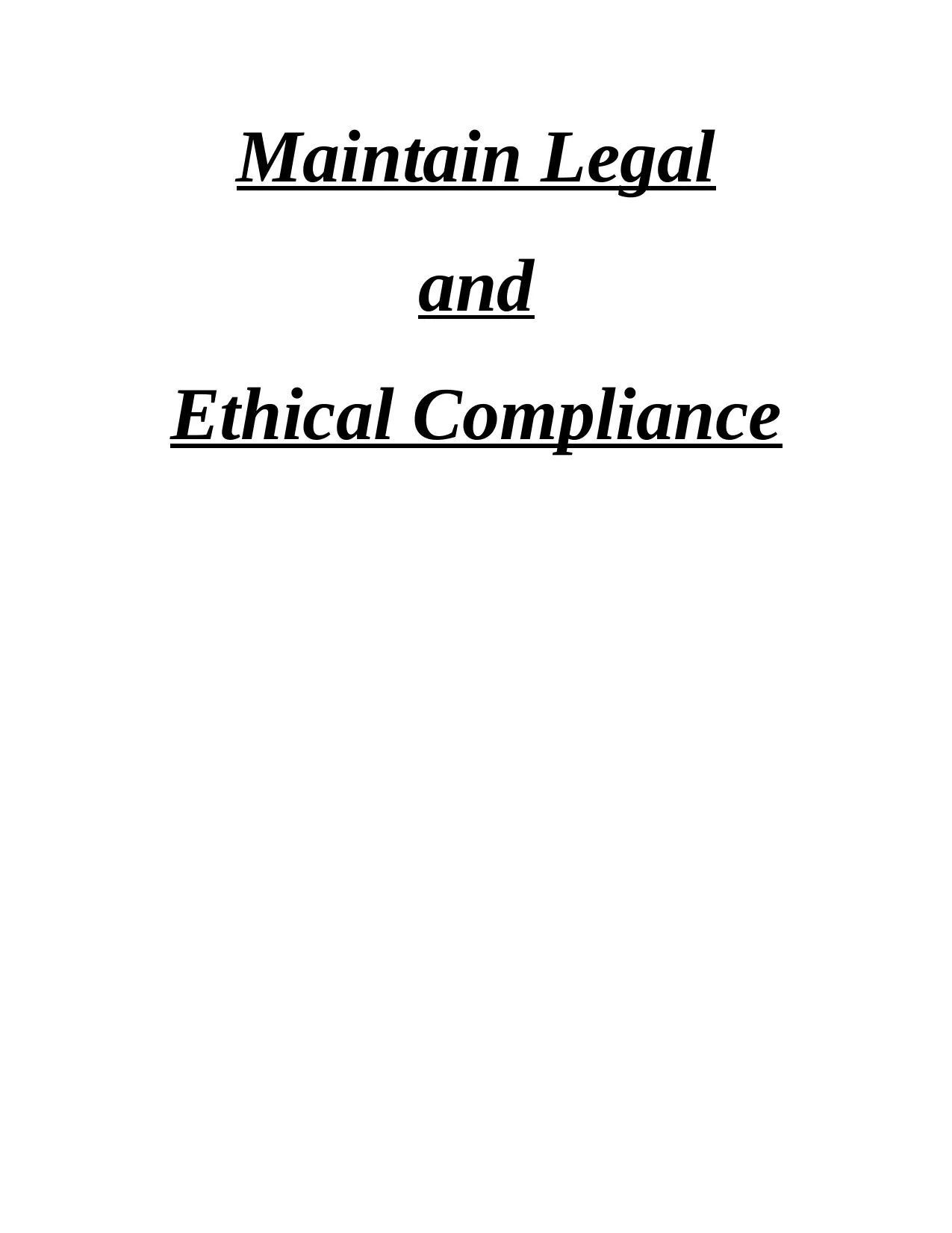
Maintain Legal
and
Ethical Compliance
and
Ethical Compliance
Paraphrase This Document
Need a fresh take? Get an instant paraphrase of this document with our AI Paraphraser
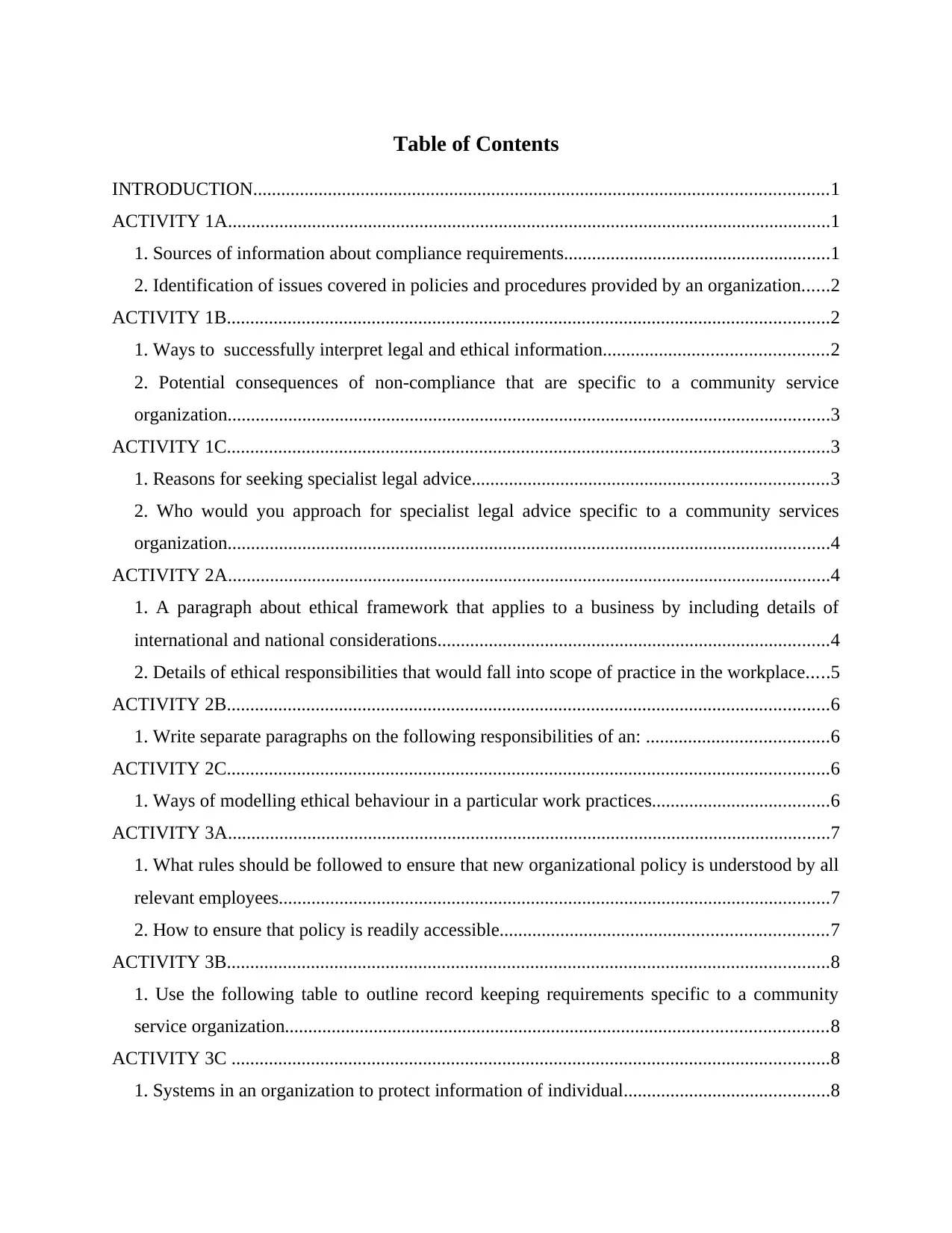
Table of Contents
INTRODUCTION...........................................................................................................................1
ACTIVITY 1A.................................................................................................................................1
1. Sources of information about compliance requirements.........................................................1
2. Identification of issues covered in policies and procedures provided by an organization......2
ACTIVITY 1B.................................................................................................................................2
1. Ways to successfully interpret legal and ethical information................................................2
2. Potential consequences of non-compliance that are specific to a community service
organization.................................................................................................................................3
ACTIVITY 1C.................................................................................................................................3
1. Reasons for seeking specialist legal advice............................................................................3
2. Who would you approach for specialist legal advice specific to a community services
organization.................................................................................................................................4
ACTIVITY 2A.................................................................................................................................4
1. A paragraph about ethical framework that applies to a business by including details of
international and national considerations....................................................................................4
2. Details of ethical responsibilities that would fall into scope of practice in the workplace.....5
ACTIVITY 2B.................................................................................................................................6
1. Write separate paragraphs on the following responsibilities of an: .......................................6
ACTIVITY 2C.................................................................................................................................6
1. Ways of modelling ethical behaviour in a particular work practices......................................6
ACTIVITY 3A.................................................................................................................................7
1. What rules should be followed to ensure that new organizational policy is understood by all
relevant employees......................................................................................................................7
2. How to ensure that policy is readily accessible......................................................................7
ACTIVITY 3B.................................................................................................................................8
1. Use the following table to outline record keeping requirements specific to a community
service organization....................................................................................................................8
ACTIVITY 3C ................................................................................................................................8
1. Systems in an organization to protect information of individual............................................8
INTRODUCTION...........................................................................................................................1
ACTIVITY 1A.................................................................................................................................1
1. Sources of information about compliance requirements.........................................................1
2. Identification of issues covered in policies and procedures provided by an organization......2
ACTIVITY 1B.................................................................................................................................2
1. Ways to successfully interpret legal and ethical information................................................2
2. Potential consequences of non-compliance that are specific to a community service
organization.................................................................................................................................3
ACTIVITY 1C.................................................................................................................................3
1. Reasons for seeking specialist legal advice............................................................................3
2. Who would you approach for specialist legal advice specific to a community services
organization.................................................................................................................................4
ACTIVITY 2A.................................................................................................................................4
1. A paragraph about ethical framework that applies to a business by including details of
international and national considerations....................................................................................4
2. Details of ethical responsibilities that would fall into scope of practice in the workplace.....5
ACTIVITY 2B.................................................................................................................................6
1. Write separate paragraphs on the following responsibilities of an: .......................................6
ACTIVITY 2C.................................................................................................................................6
1. Ways of modelling ethical behaviour in a particular work practices......................................6
ACTIVITY 3A.................................................................................................................................7
1. What rules should be followed to ensure that new organizational policy is understood by all
relevant employees......................................................................................................................7
2. How to ensure that policy is readily accessible......................................................................7
ACTIVITY 3B.................................................................................................................................8
1. Use the following table to outline record keeping requirements specific to a community
service organization....................................................................................................................8
ACTIVITY 3C ................................................................................................................................8
1. Systems in an organization to protect information of individual............................................8
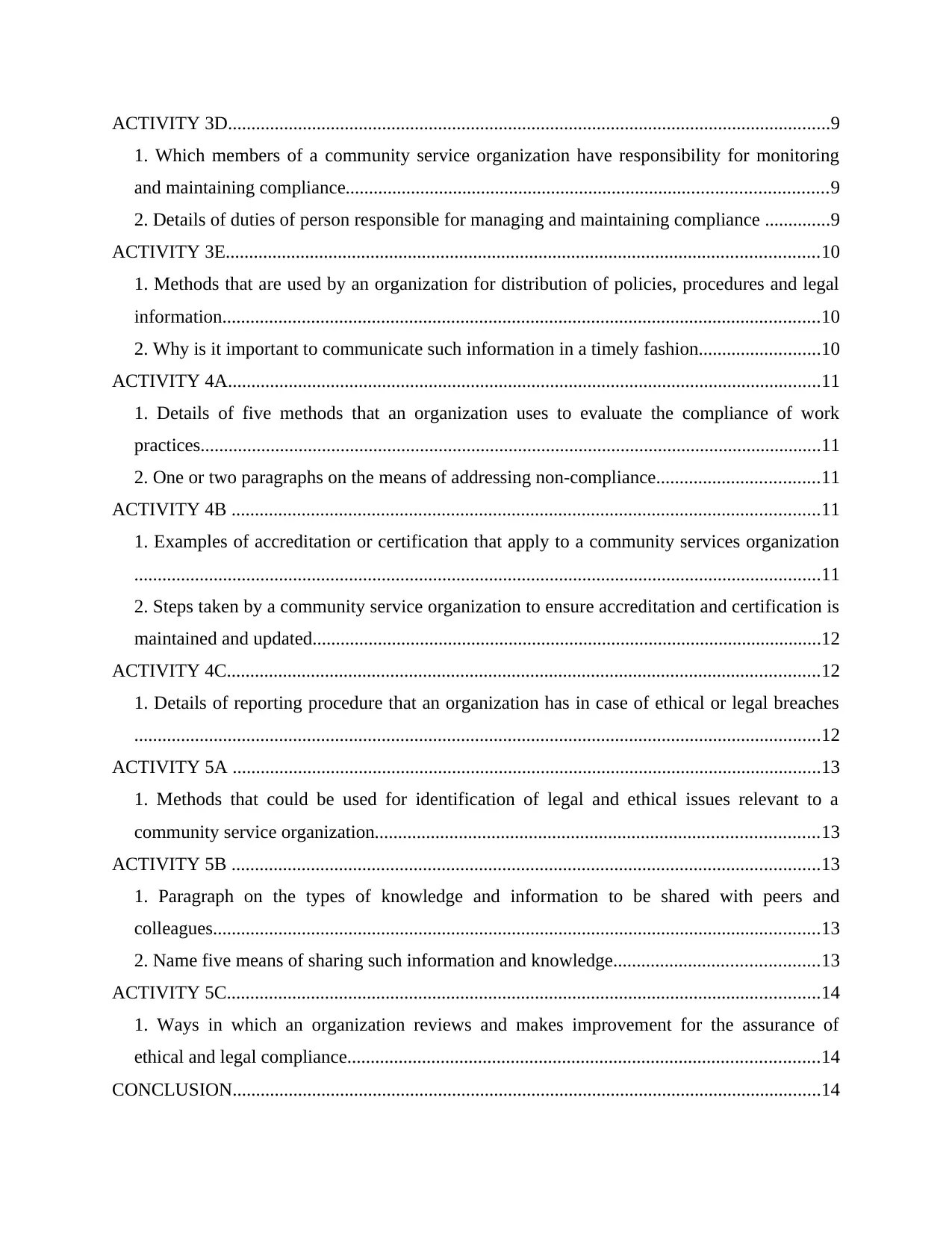
ACTIVITY 3D.................................................................................................................................9
1. Which members of a community service organization have responsibility for monitoring
and maintaining compliance.......................................................................................................9
2. Details of duties of person responsible for managing and maintaining compliance ..............9
ACTIVITY 3E...............................................................................................................................10
1. Methods that are used by an organization for distribution of policies, procedures and legal
information................................................................................................................................10
2. Why is it important to communicate such information in a timely fashion..........................10
ACTIVITY 4A...............................................................................................................................11
1. Details of five methods that an organization uses to evaluate the compliance of work
practices.....................................................................................................................................11
2. One or two paragraphs on the means of addressing non-compliance...................................11
ACTIVITY 4B ..............................................................................................................................11
1. Examples of accreditation or certification that apply to a community services organization
...................................................................................................................................................11
2. Steps taken by a community service organization to ensure accreditation and certification is
maintained and updated.............................................................................................................12
ACTIVITY 4C...............................................................................................................................12
1. Details of reporting procedure that an organization has in case of ethical or legal breaches
...................................................................................................................................................12
ACTIVITY 5A ..............................................................................................................................13
1. Methods that could be used for identification of legal and ethical issues relevant to a
community service organization...............................................................................................13
ACTIVITY 5B ..............................................................................................................................13
1. Paragraph on the types of knowledge and information to be shared with peers and
colleagues..................................................................................................................................13
2. Name five means of sharing such information and knowledge............................................13
ACTIVITY 5C...............................................................................................................................14
1. Ways in which an organization reviews and makes improvement for the assurance of
ethical and legal compliance.....................................................................................................14
CONCLUSION..............................................................................................................................14
1. Which members of a community service organization have responsibility for monitoring
and maintaining compliance.......................................................................................................9
2. Details of duties of person responsible for managing and maintaining compliance ..............9
ACTIVITY 3E...............................................................................................................................10
1. Methods that are used by an organization for distribution of policies, procedures and legal
information................................................................................................................................10
2. Why is it important to communicate such information in a timely fashion..........................10
ACTIVITY 4A...............................................................................................................................11
1. Details of five methods that an organization uses to evaluate the compliance of work
practices.....................................................................................................................................11
2. One or two paragraphs on the means of addressing non-compliance...................................11
ACTIVITY 4B ..............................................................................................................................11
1. Examples of accreditation or certification that apply to a community services organization
...................................................................................................................................................11
2. Steps taken by a community service organization to ensure accreditation and certification is
maintained and updated.............................................................................................................12
ACTIVITY 4C...............................................................................................................................12
1. Details of reporting procedure that an organization has in case of ethical or legal breaches
...................................................................................................................................................12
ACTIVITY 5A ..............................................................................................................................13
1. Methods that could be used for identification of legal and ethical issues relevant to a
community service organization...............................................................................................13
ACTIVITY 5B ..............................................................................................................................13
1. Paragraph on the types of knowledge and information to be shared with peers and
colleagues..................................................................................................................................13
2. Name five means of sharing such information and knowledge............................................13
ACTIVITY 5C...............................................................................................................................14
1. Ways in which an organization reviews and makes improvement for the assurance of
ethical and legal compliance.....................................................................................................14
CONCLUSION..............................................................................................................................14
⊘ This is a preview!⊘
Do you want full access?
Subscribe today to unlock all pages.

Trusted by 1+ million students worldwide
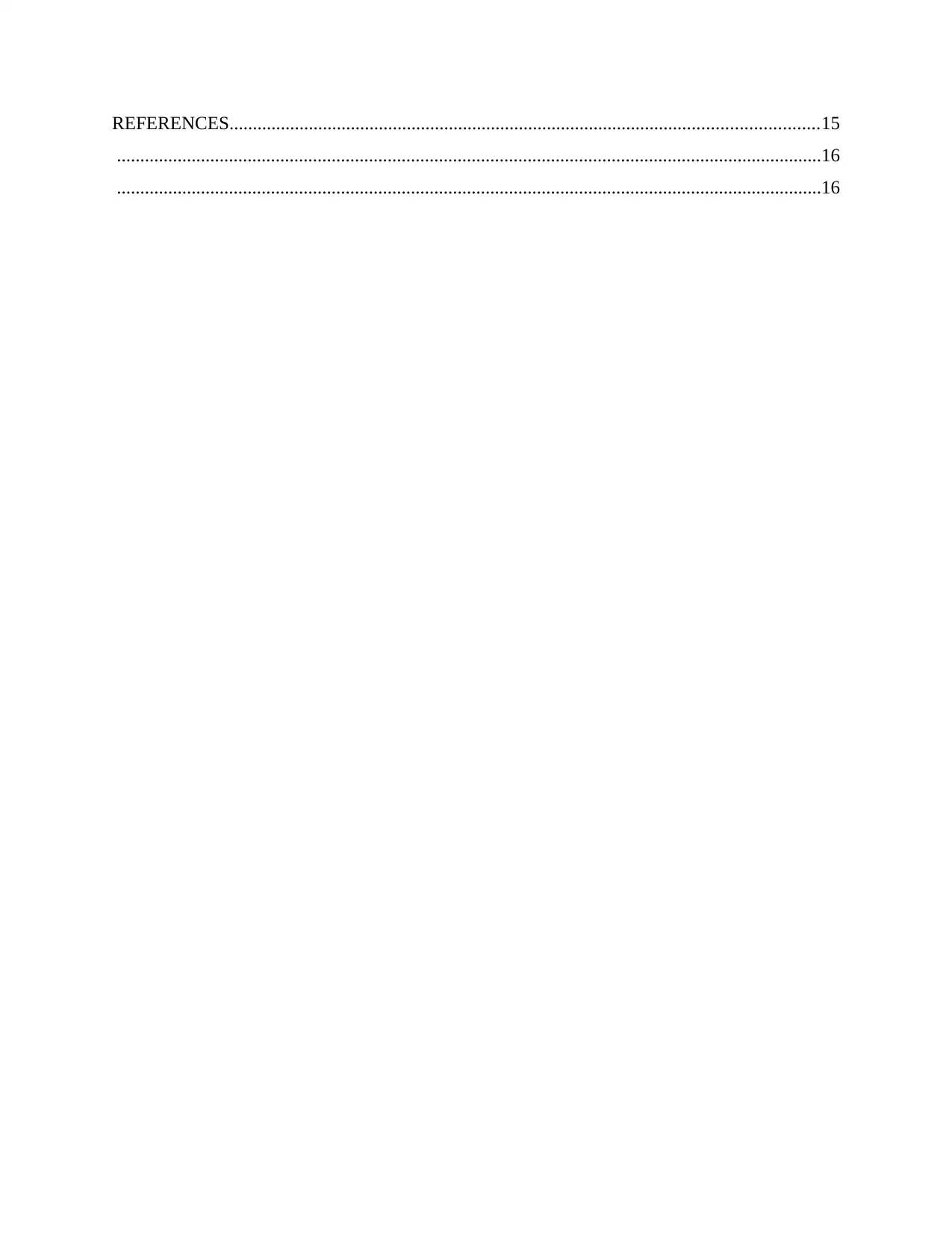
REFERENCES..............................................................................................................................15
.......................................................................................................................................................16
.......................................................................................................................................................16
.......................................................................................................................................................16
.......................................................................................................................................................16
Paraphrase This Document
Need a fresh take? Get an instant paraphrase of this document with our AI Paraphraser
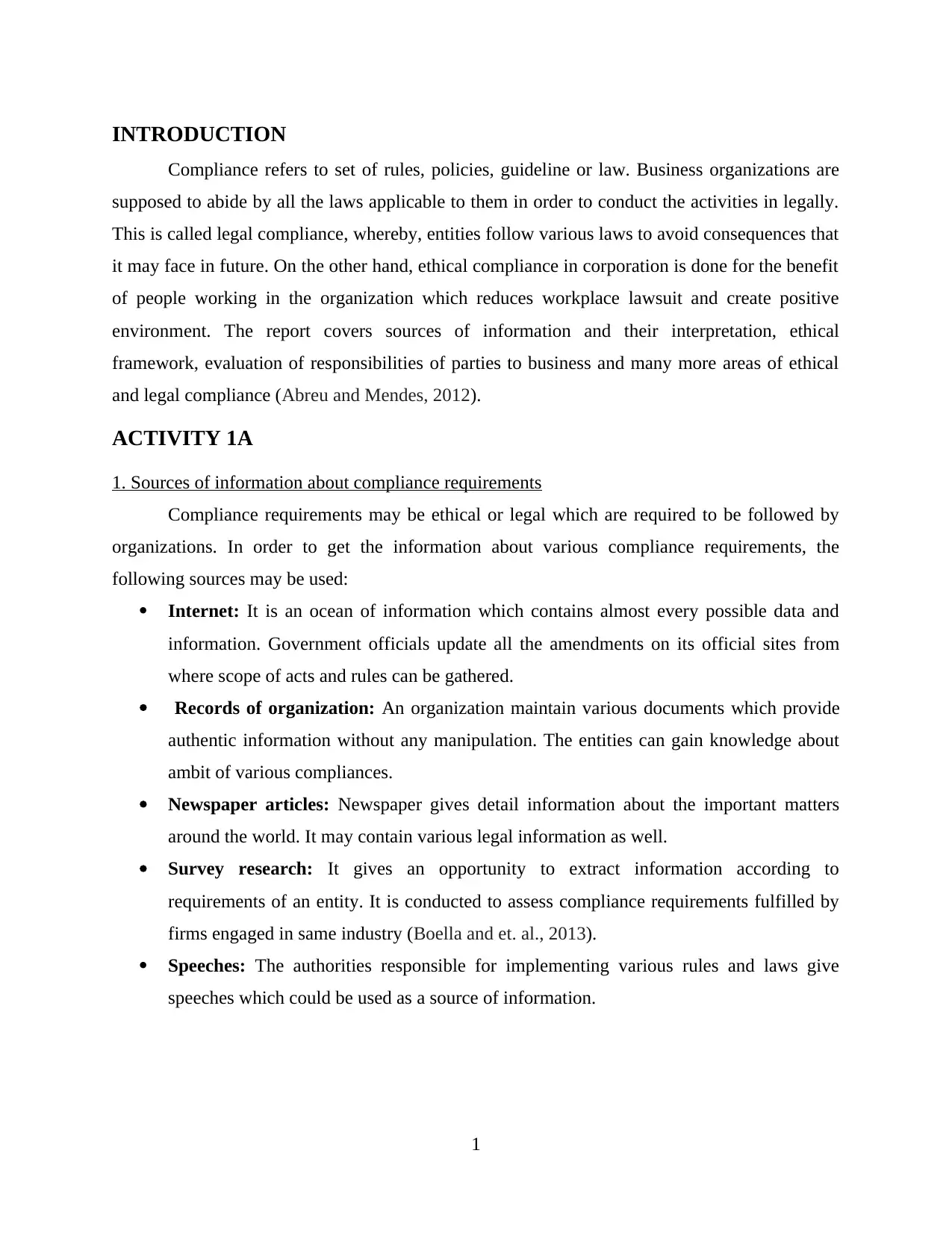
INTRODUCTION
Compliance refers to set of rules, policies, guideline or law. Business organizations are
supposed to abide by all the laws applicable to them in order to conduct the activities in legally.
This is called legal compliance, whereby, entities follow various laws to avoid consequences that
it may face in future. On the other hand, ethical compliance in corporation is done for the benefit
of people working in the organization which reduces workplace lawsuit and create positive
environment. The report covers sources of information and their interpretation, ethical
framework, evaluation of responsibilities of parties to business and many more areas of ethical
and legal compliance (Abreu and Mendes, 2012).
ACTIVITY 1A
1. Sources of information about compliance requirements
Compliance requirements may be ethical or legal which are required to be followed by
organizations. In order to get the information about various compliance requirements, the
following sources may be used:
Internet: It is an ocean of information which contains almost every possible data and
information. Government officials update all the amendments on its official sites from
where scope of acts and rules can be gathered.
Records of organization: An organization maintain various documents which provide
authentic information without any manipulation. The entities can gain knowledge about
ambit of various compliances.
Newspaper articles: Newspaper gives detail information about the important matters
around the world. It may contain various legal information as well.
Survey research: It gives an opportunity to extract information according to
requirements of an entity. It is conducted to assess compliance requirements fulfilled by
firms engaged in same industry (Boella and et. al., 2013).
Speeches: The authorities responsible for implementing various rules and laws give
speeches which could be used as a source of information.
1
Compliance refers to set of rules, policies, guideline or law. Business organizations are
supposed to abide by all the laws applicable to them in order to conduct the activities in legally.
This is called legal compliance, whereby, entities follow various laws to avoid consequences that
it may face in future. On the other hand, ethical compliance in corporation is done for the benefit
of people working in the organization which reduces workplace lawsuit and create positive
environment. The report covers sources of information and their interpretation, ethical
framework, evaluation of responsibilities of parties to business and many more areas of ethical
and legal compliance (Abreu and Mendes, 2012).
ACTIVITY 1A
1. Sources of information about compliance requirements
Compliance requirements may be ethical or legal which are required to be followed by
organizations. In order to get the information about various compliance requirements, the
following sources may be used:
Internet: It is an ocean of information which contains almost every possible data and
information. Government officials update all the amendments on its official sites from
where scope of acts and rules can be gathered.
Records of organization: An organization maintain various documents which provide
authentic information without any manipulation. The entities can gain knowledge about
ambit of various compliances.
Newspaper articles: Newspaper gives detail information about the important matters
around the world. It may contain various legal information as well.
Survey research: It gives an opportunity to extract information according to
requirements of an entity. It is conducted to assess compliance requirements fulfilled by
firms engaged in same industry (Boella and et. al., 2013).
Speeches: The authorities responsible for implementing various rules and laws give
speeches which could be used as a source of information.
1
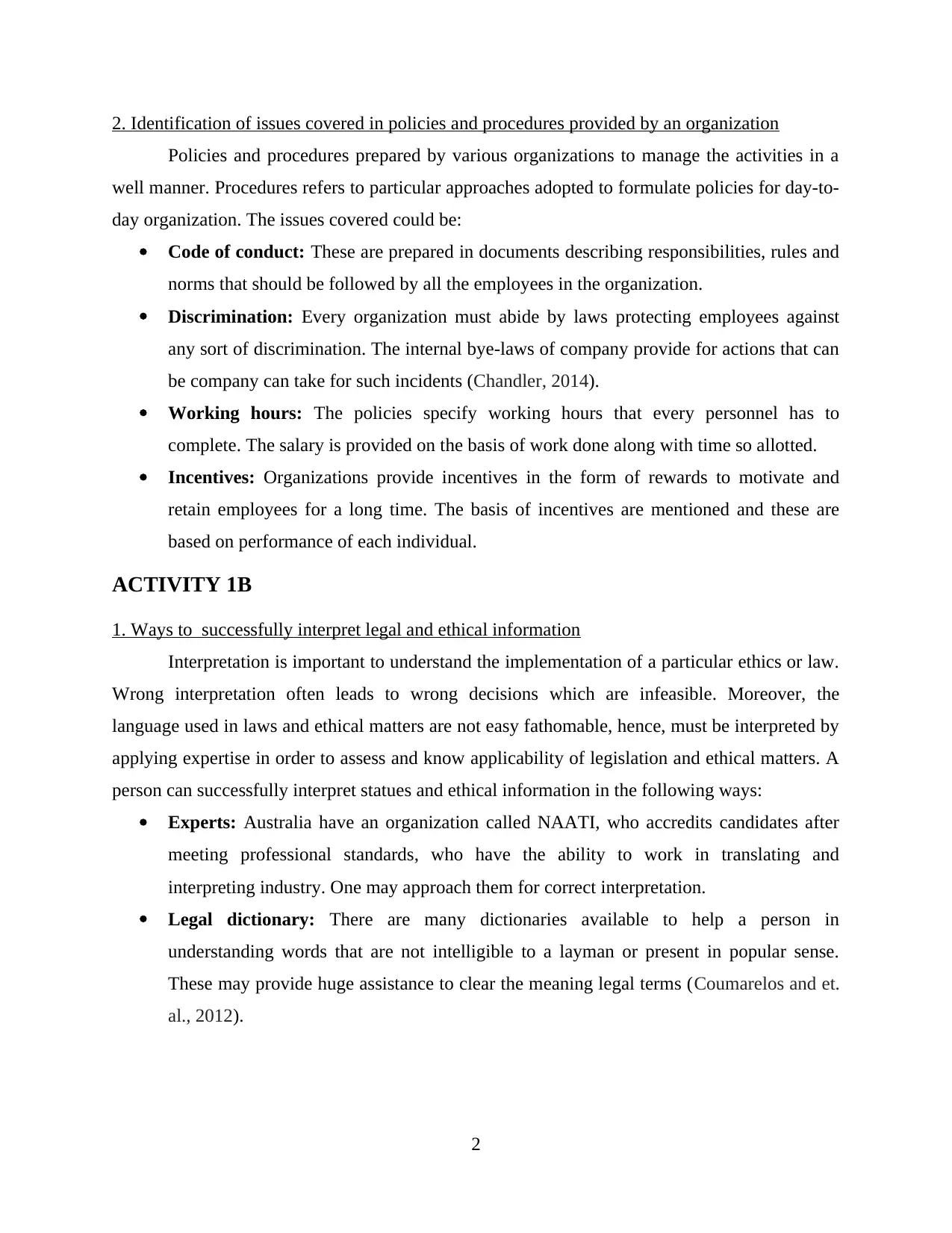
2. Identification of issues covered in policies and procedures provided by an organization
Policies and procedures prepared by various organizations to manage the activities in a
well manner. Procedures refers to particular approaches adopted to formulate policies for day-to-
day organization. The issues covered could be:
Code of conduct: These are prepared in documents describing responsibilities, rules and
norms that should be followed by all the employees in the organization.
Discrimination: Every organization must abide by laws protecting employees against
any sort of discrimination. The internal bye-laws of company provide for actions that can
be company can take for such incidents (Chandler, 2014).
Working hours: The policies specify working hours that every personnel has to
complete. The salary is provided on the basis of work done along with time so allotted.
Incentives: Organizations provide incentives in the form of rewards to motivate and
retain employees for a long time. The basis of incentives are mentioned and these are
based on performance of each individual.
ACTIVITY 1B
1. Ways to successfully interpret legal and ethical information
Interpretation is important to understand the implementation of a particular ethics or law.
Wrong interpretation often leads to wrong decisions which are infeasible. Moreover, the
language used in laws and ethical matters are not easy fathomable, hence, must be interpreted by
applying expertise in order to assess and know applicability of legislation and ethical matters. A
person can successfully interpret statues and ethical information in the following ways:
Experts: Australia have an organization called NAATI, who accredits candidates after
meeting professional standards, who have the ability to work in translating and
interpreting industry. One may approach them for correct interpretation.
Legal dictionary: There are many dictionaries available to help a person in
understanding words that are not intelligible to a layman or present in popular sense.
These may provide huge assistance to clear the meaning legal terms (Coumarelos and et.
al., 2012).
2
Policies and procedures prepared by various organizations to manage the activities in a
well manner. Procedures refers to particular approaches adopted to formulate policies for day-to-
day organization. The issues covered could be:
Code of conduct: These are prepared in documents describing responsibilities, rules and
norms that should be followed by all the employees in the organization.
Discrimination: Every organization must abide by laws protecting employees against
any sort of discrimination. The internal bye-laws of company provide for actions that can
be company can take for such incidents (Chandler, 2014).
Working hours: The policies specify working hours that every personnel has to
complete. The salary is provided on the basis of work done along with time so allotted.
Incentives: Organizations provide incentives in the form of rewards to motivate and
retain employees for a long time. The basis of incentives are mentioned and these are
based on performance of each individual.
ACTIVITY 1B
1. Ways to successfully interpret legal and ethical information
Interpretation is important to understand the implementation of a particular ethics or law.
Wrong interpretation often leads to wrong decisions which are infeasible. Moreover, the
language used in laws and ethical matters are not easy fathomable, hence, must be interpreted by
applying expertise in order to assess and know applicability of legislation and ethical matters. A
person can successfully interpret statues and ethical information in the following ways:
Experts: Australia have an organization called NAATI, who accredits candidates after
meeting professional standards, who have the ability to work in translating and
interpreting industry. One may approach them for correct interpretation.
Legal dictionary: There are many dictionaries available to help a person in
understanding words that are not intelligible to a layman or present in popular sense.
These may provide huge assistance to clear the meaning legal terms (Coumarelos and et.
al., 2012).
2
⊘ This is a preview!⊘
Do you want full access?
Subscribe today to unlock all pages.

Trusted by 1+ million students worldwide
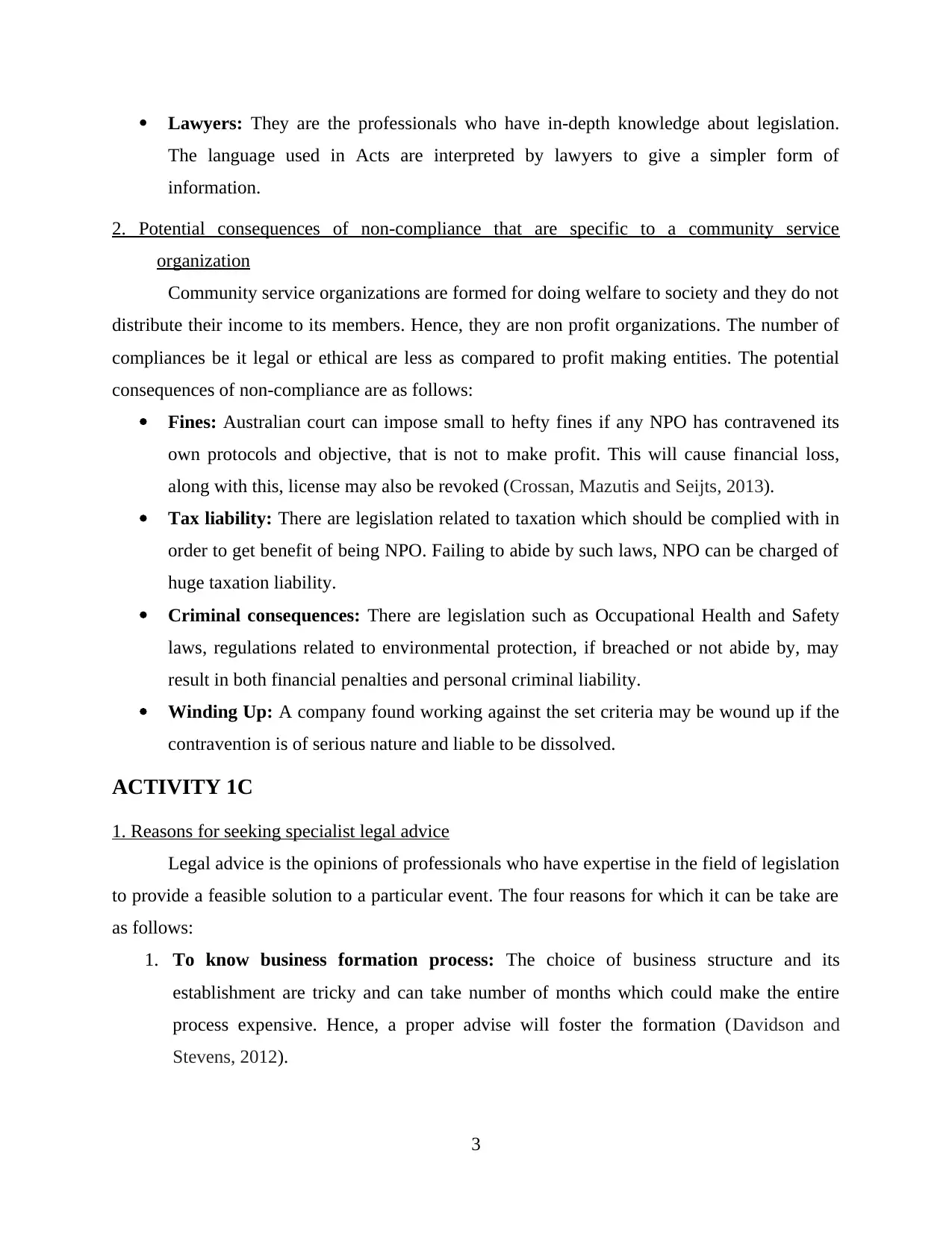
Lawyers: They are the professionals who have in-depth knowledge about legislation.
The language used in Acts are interpreted by lawyers to give a simpler form of
information.
2. Potential consequences of non-compliance that are specific to a community service
organization
Community service organizations are formed for doing welfare to society and they do not
distribute their income to its members. Hence, they are non profit organizations. The number of
compliances be it legal or ethical are less as compared to profit making entities. The potential
consequences of non-compliance are as follows:
Fines: Australian court can impose small to hefty fines if any NPO has contravened its
own protocols and objective, that is not to make profit. This will cause financial loss,
along with this, license may also be revoked (Crossan, Mazutis and Seijts, 2013).
Tax liability: There are legislation related to taxation which should be complied with in
order to get benefit of being NPO. Failing to abide by such laws, NPO can be charged of
huge taxation liability.
Criminal consequences: There are legislation such as Occupational Health and Safety
laws, regulations related to environmental protection, if breached or not abide by, may
result in both financial penalties and personal criminal liability.
Winding Up: A company found working against the set criteria may be wound up if the
contravention is of serious nature and liable to be dissolved.
ACTIVITY 1C
1. Reasons for seeking specialist legal advice
Legal advice is the opinions of professionals who have expertise in the field of legislation
to provide a feasible solution to a particular event. The four reasons for which it can be take are
as follows:
1. To know business formation process: The choice of business structure and its
establishment are tricky and can take number of months which could make the entire
process expensive. Hence, a proper advise will foster the formation (Davidson and
Stevens, 2012).
3
The language used in Acts are interpreted by lawyers to give a simpler form of
information.
2. Potential consequences of non-compliance that are specific to a community service
organization
Community service organizations are formed for doing welfare to society and they do not
distribute their income to its members. Hence, they are non profit organizations. The number of
compliances be it legal or ethical are less as compared to profit making entities. The potential
consequences of non-compliance are as follows:
Fines: Australian court can impose small to hefty fines if any NPO has contravened its
own protocols and objective, that is not to make profit. This will cause financial loss,
along with this, license may also be revoked (Crossan, Mazutis and Seijts, 2013).
Tax liability: There are legislation related to taxation which should be complied with in
order to get benefit of being NPO. Failing to abide by such laws, NPO can be charged of
huge taxation liability.
Criminal consequences: There are legislation such as Occupational Health and Safety
laws, regulations related to environmental protection, if breached or not abide by, may
result in both financial penalties and personal criminal liability.
Winding Up: A company found working against the set criteria may be wound up if the
contravention is of serious nature and liable to be dissolved.
ACTIVITY 1C
1. Reasons for seeking specialist legal advice
Legal advice is the opinions of professionals who have expertise in the field of legislation
to provide a feasible solution to a particular event. The four reasons for which it can be take are
as follows:
1. To know business formation process: The choice of business structure and its
establishment are tricky and can take number of months which could make the entire
process expensive. Hence, a proper advise will foster the formation (Davidson and
Stevens, 2012).
3
Paraphrase This Document
Need a fresh take? Get an instant paraphrase of this document with our AI Paraphraser
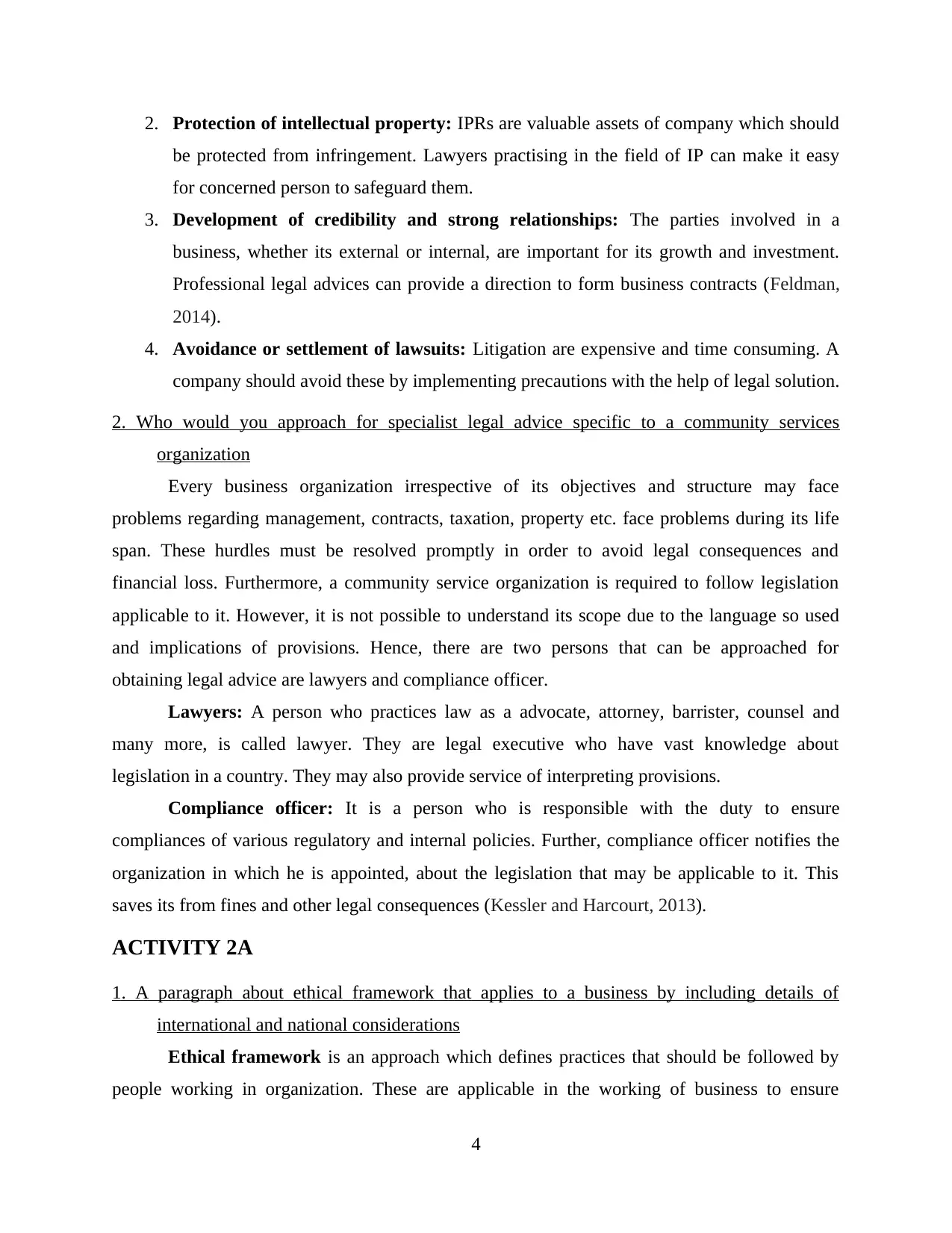
2. Protection of intellectual property: IPRs are valuable assets of company which should
be protected from infringement. Lawyers practising in the field of IP can make it easy
for concerned person to safeguard them.
3. Development of credibility and strong relationships: The parties involved in a
business, whether its external or internal, are important for its growth and investment.
Professional legal advices can provide a direction to form business contracts (Feldman,
2014).
4. Avoidance or settlement of lawsuits: Litigation are expensive and time consuming. A
company should avoid these by implementing precautions with the help of legal solution.
2. Who would you approach for specialist legal advice specific to a community services
organization
Every business organization irrespective of its objectives and structure may face
problems regarding management, contracts, taxation, property etc. face problems during its life
span. These hurdles must be resolved promptly in order to avoid legal consequences and
financial loss. Furthermore, a community service organization is required to follow legislation
applicable to it. However, it is not possible to understand its scope due to the language so used
and implications of provisions. Hence, there are two persons that can be approached for
obtaining legal advice are lawyers and compliance officer.
Lawyers: A person who practices law as a advocate, attorney, barrister, counsel and
many more, is called lawyer. They are legal executive who have vast knowledge about
legislation in a country. They may also provide service of interpreting provisions.
Compliance officer: It is a person who is responsible with the duty to ensure
compliances of various regulatory and internal policies. Further, compliance officer notifies the
organization in which he is appointed, about the legislation that may be applicable to it. This
saves its from fines and other legal consequences (Kessler and Harcourt, 2013).
ACTIVITY 2A
1. A paragraph about ethical framework that applies to a business by including details of
international and national considerations
Ethical framework is an approach which defines practices that should be followed by
people working in organization. These are applicable in the working of business to ensure
4
be protected from infringement. Lawyers practising in the field of IP can make it easy
for concerned person to safeguard them.
3. Development of credibility and strong relationships: The parties involved in a
business, whether its external or internal, are important for its growth and investment.
Professional legal advices can provide a direction to form business contracts (Feldman,
2014).
4. Avoidance or settlement of lawsuits: Litigation are expensive and time consuming. A
company should avoid these by implementing precautions with the help of legal solution.
2. Who would you approach for specialist legal advice specific to a community services
organization
Every business organization irrespective of its objectives and structure may face
problems regarding management, contracts, taxation, property etc. face problems during its life
span. These hurdles must be resolved promptly in order to avoid legal consequences and
financial loss. Furthermore, a community service organization is required to follow legislation
applicable to it. However, it is not possible to understand its scope due to the language so used
and implications of provisions. Hence, there are two persons that can be approached for
obtaining legal advice are lawyers and compliance officer.
Lawyers: A person who practices law as a advocate, attorney, barrister, counsel and
many more, is called lawyer. They are legal executive who have vast knowledge about
legislation in a country. They may also provide service of interpreting provisions.
Compliance officer: It is a person who is responsible with the duty to ensure
compliances of various regulatory and internal policies. Further, compliance officer notifies the
organization in which he is appointed, about the legislation that may be applicable to it. This
saves its from fines and other legal consequences (Kessler and Harcourt, 2013).
ACTIVITY 2A
1. A paragraph about ethical framework that applies to a business by including details of
international and national considerations
Ethical framework is an approach which defines practices that should be followed by
people working in organization. These are applicable in the working of business to ensure
4
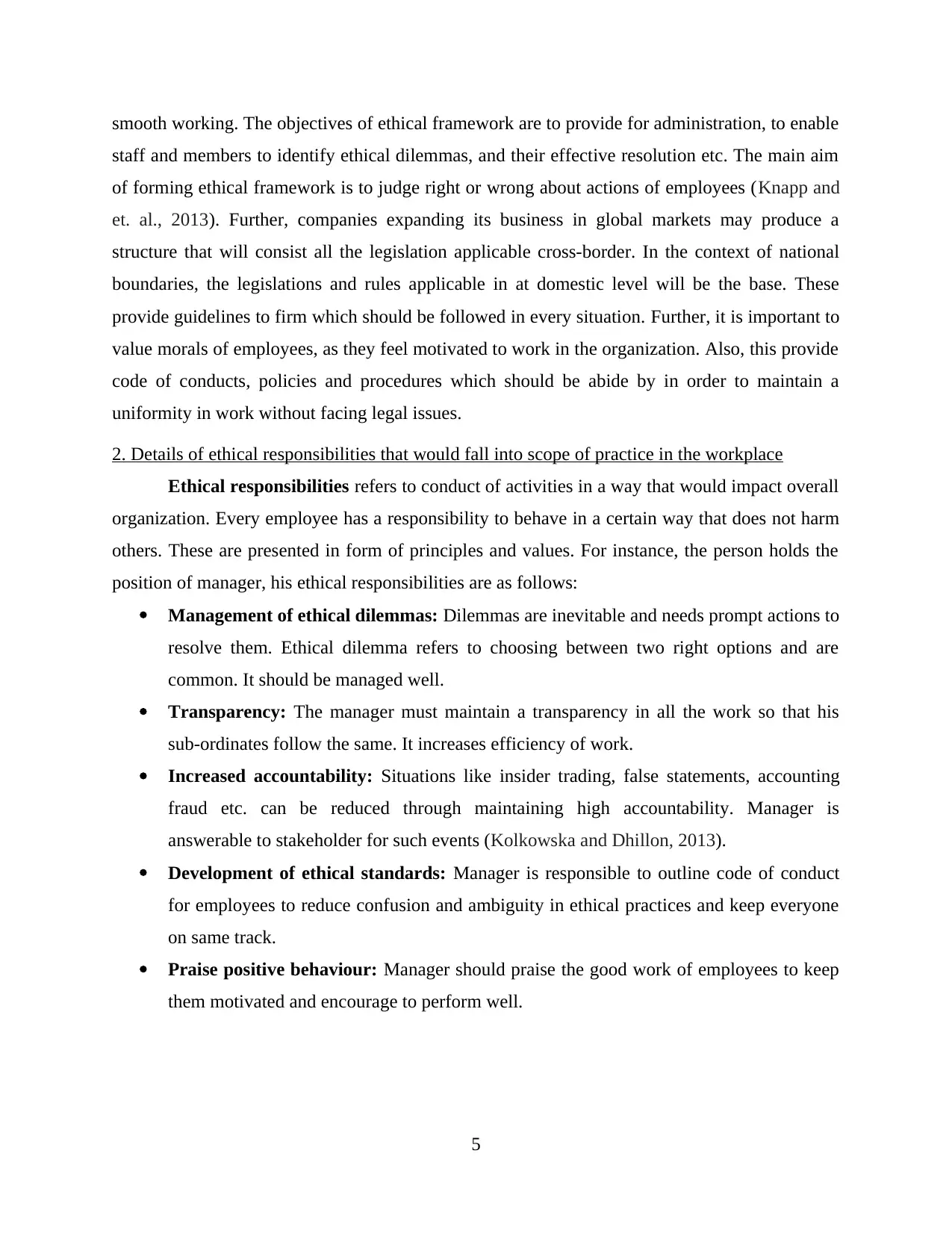
smooth working. The objectives of ethical framework are to provide for administration, to enable
staff and members to identify ethical dilemmas, and their effective resolution etc. The main aim
of forming ethical framework is to judge right or wrong about actions of employees (Knapp and
et. al., 2013). Further, companies expanding its business in global markets may produce a
structure that will consist all the legislation applicable cross-border. In the context of national
boundaries, the legislations and rules applicable in at domestic level will be the base. These
provide guidelines to firm which should be followed in every situation. Further, it is important to
value morals of employees, as they feel motivated to work in the organization. Also, this provide
code of conducts, policies and procedures which should be abide by in order to maintain a
uniformity in work without facing legal issues.
2. Details of ethical responsibilities that would fall into scope of practice in the workplace
Ethical responsibilities refers to conduct of activities in a way that would impact overall
organization. Every employee has a responsibility to behave in a certain way that does not harm
others. These are presented in form of principles and values. For instance, the person holds the
position of manager, his ethical responsibilities are as follows:
Management of ethical dilemmas: Dilemmas are inevitable and needs prompt actions to
resolve them. Ethical dilemma refers to choosing between two right options and are
common. It should be managed well.
Transparency: The manager must maintain a transparency in all the work so that his
sub-ordinates follow the same. It increases efficiency of work.
Increased accountability: Situations like insider trading, false statements, accounting
fraud etc. can be reduced through maintaining high accountability. Manager is
answerable to stakeholder for such events (Kolkowska and Dhillon, 2013).
Development of ethical standards: Manager is responsible to outline code of conduct
for employees to reduce confusion and ambiguity in ethical practices and keep everyone
on same track.
Praise positive behaviour: Manager should praise the good work of employees to keep
them motivated and encourage to perform well.
5
staff and members to identify ethical dilemmas, and their effective resolution etc. The main aim
of forming ethical framework is to judge right or wrong about actions of employees (Knapp and
et. al., 2013). Further, companies expanding its business in global markets may produce a
structure that will consist all the legislation applicable cross-border. In the context of national
boundaries, the legislations and rules applicable in at domestic level will be the base. These
provide guidelines to firm which should be followed in every situation. Further, it is important to
value morals of employees, as they feel motivated to work in the organization. Also, this provide
code of conducts, policies and procedures which should be abide by in order to maintain a
uniformity in work without facing legal issues.
2. Details of ethical responsibilities that would fall into scope of practice in the workplace
Ethical responsibilities refers to conduct of activities in a way that would impact overall
organization. Every employee has a responsibility to behave in a certain way that does not harm
others. These are presented in form of principles and values. For instance, the person holds the
position of manager, his ethical responsibilities are as follows:
Management of ethical dilemmas: Dilemmas are inevitable and needs prompt actions to
resolve them. Ethical dilemma refers to choosing between two right options and are
common. It should be managed well.
Transparency: The manager must maintain a transparency in all the work so that his
sub-ordinates follow the same. It increases efficiency of work.
Increased accountability: Situations like insider trading, false statements, accounting
fraud etc. can be reduced through maintaining high accountability. Manager is
answerable to stakeholder for such events (Kolkowska and Dhillon, 2013).
Development of ethical standards: Manager is responsible to outline code of conduct
for employees to reduce confusion and ambiguity in ethical practices and keep everyone
on same track.
Praise positive behaviour: Manager should praise the good work of employees to keep
them motivated and encourage to perform well.
5
⊘ This is a preview!⊘
Do you want full access?
Subscribe today to unlock all pages.

Trusted by 1+ million students worldwide
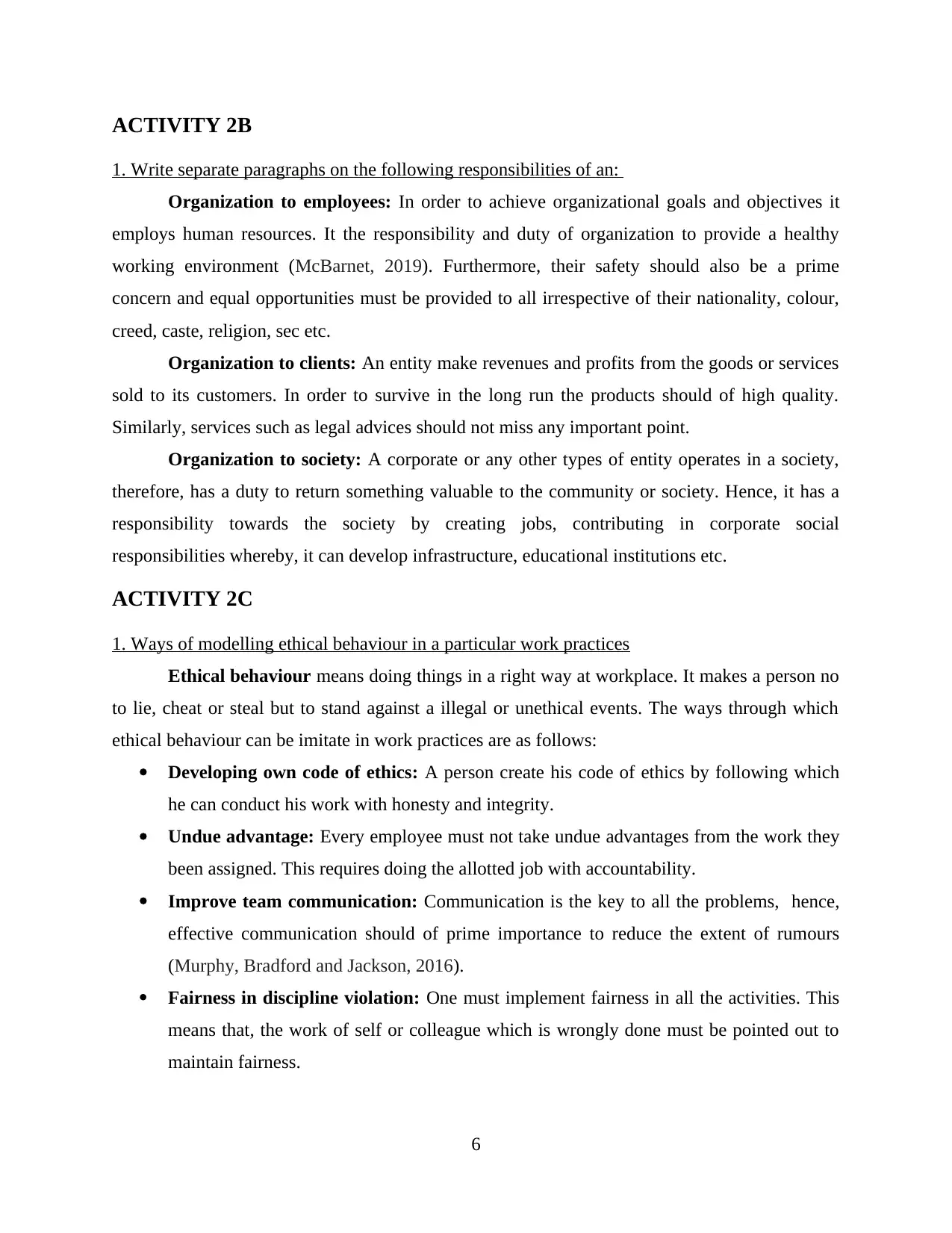
ACTIVITY 2B
1. Write separate paragraphs on the following responsibilities of an:
Organization to employees: In order to achieve organizational goals and objectives it
employs human resources. It the responsibility and duty of organization to provide a healthy
working environment (McBarnet, 2019). Furthermore, their safety should also be a prime
concern and equal opportunities must be provided to all irrespective of their nationality, colour,
creed, caste, religion, sec etc.
Organization to clients: An entity make revenues and profits from the goods or services
sold to its customers. In order to survive in the long run the products should of high quality.
Similarly, services such as legal advices should not miss any important point.
Organization to society: A corporate or any other types of entity operates in a society,
therefore, has a duty to return something valuable to the community or society. Hence, it has a
responsibility towards the society by creating jobs, contributing in corporate social
responsibilities whereby, it can develop infrastructure, educational institutions etc.
ACTIVITY 2C
1. Ways of modelling ethical behaviour in a particular work practices
Ethical behaviour means doing things in a right way at workplace. It makes a person no
to lie, cheat or steal but to stand against a illegal or unethical events. The ways through which
ethical behaviour can be imitate in work practices are as follows:
Developing own code of ethics: A person create his code of ethics by following which
he can conduct his work with honesty and integrity.
Undue advantage: Every employee must not take undue advantages from the work they
been assigned. This requires doing the allotted job with accountability.
Improve team communication: Communication is the key to all the problems, hence,
effective communication should of prime importance to reduce the extent of rumours
(Murphy, Bradford and Jackson, 2016).
Fairness in discipline violation: One must implement fairness in all the activities. This
means that, the work of self or colleague which is wrongly done must be pointed out to
maintain fairness.
6
1. Write separate paragraphs on the following responsibilities of an:
Organization to employees: In order to achieve organizational goals and objectives it
employs human resources. It the responsibility and duty of organization to provide a healthy
working environment (McBarnet, 2019). Furthermore, their safety should also be a prime
concern and equal opportunities must be provided to all irrespective of their nationality, colour,
creed, caste, religion, sec etc.
Organization to clients: An entity make revenues and profits from the goods or services
sold to its customers. In order to survive in the long run the products should of high quality.
Similarly, services such as legal advices should not miss any important point.
Organization to society: A corporate or any other types of entity operates in a society,
therefore, has a duty to return something valuable to the community or society. Hence, it has a
responsibility towards the society by creating jobs, contributing in corporate social
responsibilities whereby, it can develop infrastructure, educational institutions etc.
ACTIVITY 2C
1. Ways of modelling ethical behaviour in a particular work practices
Ethical behaviour means doing things in a right way at workplace. It makes a person no
to lie, cheat or steal but to stand against a illegal or unethical events. The ways through which
ethical behaviour can be imitate in work practices are as follows:
Developing own code of ethics: A person create his code of ethics by following which
he can conduct his work with honesty and integrity.
Undue advantage: Every employee must not take undue advantages from the work they
been assigned. This requires doing the allotted job with accountability.
Improve team communication: Communication is the key to all the problems, hence,
effective communication should of prime importance to reduce the extent of rumours
(Murphy, Bradford and Jackson, 2016).
Fairness in discipline violation: One must implement fairness in all the activities. This
means that, the work of self or colleague which is wrongly done must be pointed out to
maintain fairness.
6
Paraphrase This Document
Need a fresh take? Get an instant paraphrase of this document with our AI Paraphraser
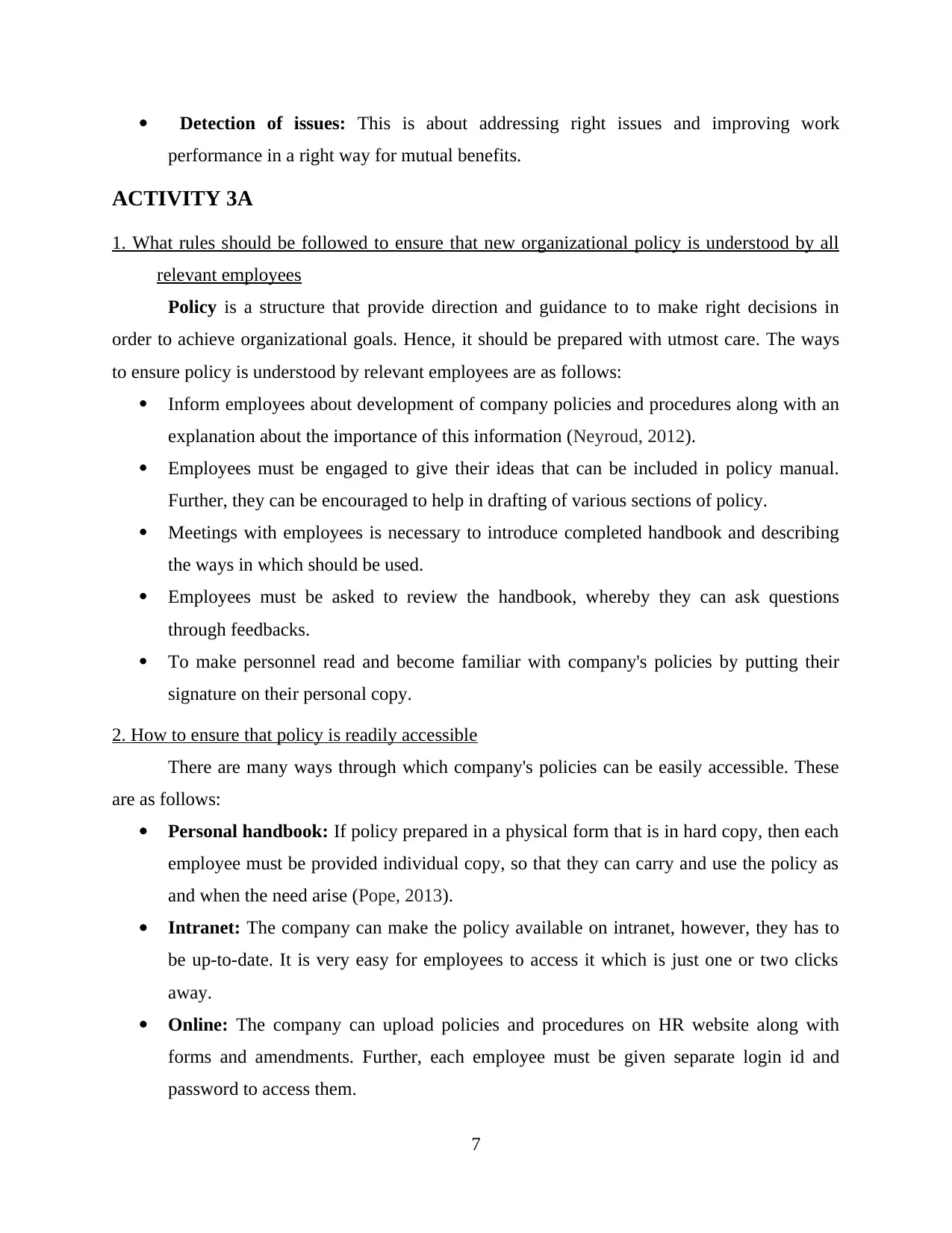
Detection of issues: This is about addressing right issues and improving work
performance in a right way for mutual benefits.
ACTIVITY 3A
1. What rules should be followed to ensure that new organizational policy is understood by all
relevant employees
Policy is a structure that provide direction and guidance to to make right decisions in
order to achieve organizational goals. Hence, it should be prepared with utmost care. The ways
to ensure policy is understood by relevant employees are as follows:
Inform employees about development of company policies and procedures along with an
explanation about the importance of this information (Neyroud, 2012).
Employees must be engaged to give their ideas that can be included in policy manual.
Further, they can be encouraged to help in drafting of various sections of policy.
Meetings with employees is necessary to introduce completed handbook and describing
the ways in which should be used.
Employees must be asked to review the handbook, whereby they can ask questions
through feedbacks.
To make personnel read and become familiar with company's policies by putting their
signature on their personal copy.
2. How to ensure that policy is readily accessible
There are many ways through which company's policies can be easily accessible. These
are as follows:
Personal handbook: If policy prepared in a physical form that is in hard copy, then each
employee must be provided individual copy, so that they can carry and use the policy as
and when the need arise (Pope, 2013).
Intranet: The company can make the policy available on intranet, however, they has to
be up-to-date. It is very easy for employees to access it which is just one or two clicks
away.
Online: The company can upload policies and procedures on HR website along with
forms and amendments. Further, each employee must be given separate login id and
password to access them.
7
performance in a right way for mutual benefits.
ACTIVITY 3A
1. What rules should be followed to ensure that new organizational policy is understood by all
relevant employees
Policy is a structure that provide direction and guidance to to make right decisions in
order to achieve organizational goals. Hence, it should be prepared with utmost care. The ways
to ensure policy is understood by relevant employees are as follows:
Inform employees about development of company policies and procedures along with an
explanation about the importance of this information (Neyroud, 2012).
Employees must be engaged to give their ideas that can be included in policy manual.
Further, they can be encouraged to help in drafting of various sections of policy.
Meetings with employees is necessary to introduce completed handbook and describing
the ways in which should be used.
Employees must be asked to review the handbook, whereby they can ask questions
through feedbacks.
To make personnel read and become familiar with company's policies by putting their
signature on their personal copy.
2. How to ensure that policy is readily accessible
There are many ways through which company's policies can be easily accessible. These
are as follows:
Personal handbook: If policy prepared in a physical form that is in hard copy, then each
employee must be provided individual copy, so that they can carry and use the policy as
and when the need arise (Pope, 2013).
Intranet: The company can make the policy available on intranet, however, they has to
be up-to-date. It is very easy for employees to access it which is just one or two clicks
away.
Online: The company can upload policies and procedures on HR website along with
forms and amendments. Further, each employee must be given separate login id and
password to access them.
7
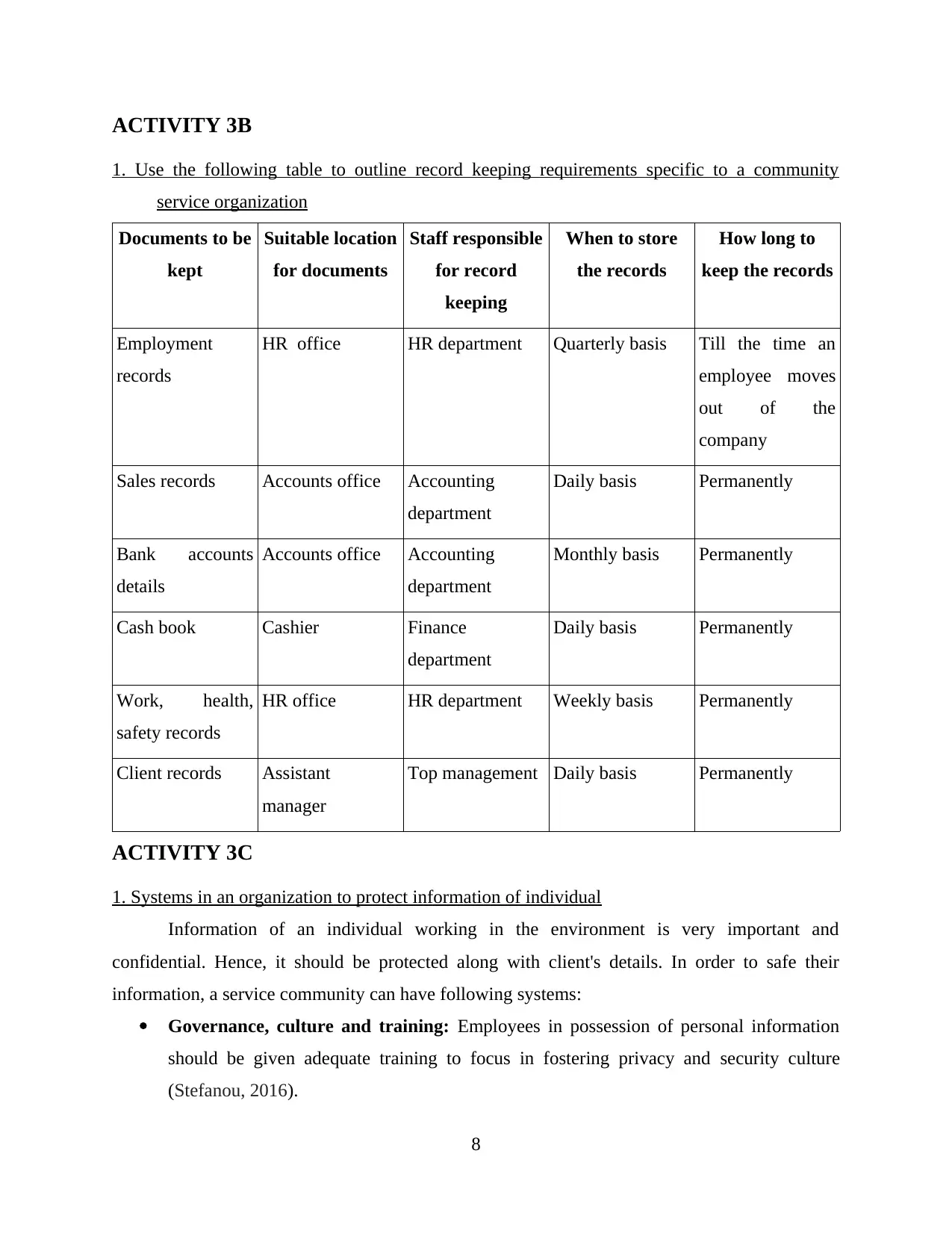
ACTIVITY 3B
1. Use the following table to outline record keeping requirements specific to a community
service organization
Documents to be
kept
Suitable location
for documents
Staff responsible
for record
keeping
When to store
the records
How long to
keep the records
Employment
records
HR office HR department Quarterly basis Till the time an
employee moves
out of the
company
Sales records Accounts office Accounting
department
Daily basis Permanently
Bank accounts
details
Accounts office Accounting
department
Monthly basis Permanently
Cash book Cashier Finance
department
Daily basis Permanently
Work, health,
safety records
HR office HR department Weekly basis Permanently
Client records Assistant
manager
Top management Daily basis Permanently
ACTIVITY 3C
1. Systems in an organization to protect information of individual
Information of an individual working in the environment is very important and
confidential. Hence, it should be protected along with client's details. In order to safe their
information, a service community can have following systems:
Governance, culture and training: Employees in possession of personal information
should be given adequate training to focus in fostering privacy and security culture
(Stefanou, 2016).
8
1. Use the following table to outline record keeping requirements specific to a community
service organization
Documents to be
kept
Suitable location
for documents
Staff responsible
for record
keeping
When to store
the records
How long to
keep the records
Employment
records
HR office HR department Quarterly basis Till the time an
employee moves
out of the
company
Sales records Accounts office Accounting
department
Daily basis Permanently
Bank accounts
details
Accounts office Accounting
department
Monthly basis Permanently
Cash book Cashier Finance
department
Daily basis Permanently
Work, health,
safety records
HR office HR department Weekly basis Permanently
Client records Assistant
manager
Top management Daily basis Permanently
ACTIVITY 3C
1. Systems in an organization to protect information of individual
Information of an individual working in the environment is very important and
confidential. Hence, it should be protected along with client's details. In order to safe their
information, a service community can have following systems:
Governance, culture and training: Employees in possession of personal information
should be given adequate training to focus in fostering privacy and security culture
(Stefanou, 2016).
8
⊘ This is a preview!⊘
Do you want full access?
Subscribe today to unlock all pages.

Trusted by 1+ million students worldwide
1 out of 20
Related Documents
Your All-in-One AI-Powered Toolkit for Academic Success.
+13062052269
info@desklib.com
Available 24*7 on WhatsApp / Email
![[object Object]](/_next/static/media/star-bottom.7253800d.svg)
Unlock your academic potential
Copyright © 2020–2025 A2Z Services. All Rights Reserved. Developed and managed by ZUCOL.





